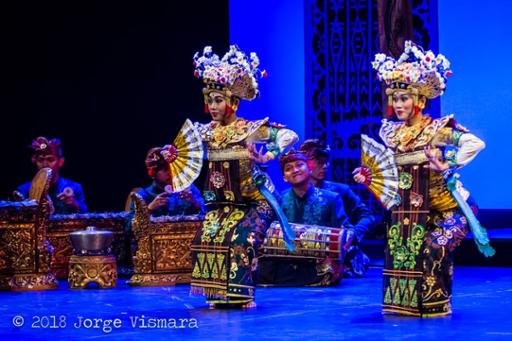Musical Trip to Bali
Gamelan
Gamelan is traditional percussive music that accompanies the life of Balinese people and is an integral part of the culture. Its name is from the Javanese word for hammer, gamel. Gamelan may also be referred to as gangsa which is Javanese for “bronze." Metallophones, the instruments used in gamelan music, are made of bronze. It is performed by itself as well as with dance and with shadow puppets.
Gamelan music is ancient. Originating from Java and Bali, it was created around 230 AD. In Javanese mythology it is thought to have been created by a god to convey messages. It is said this is why this god created the gong and played gamelan. The photo below is a Balinese gamelan performance (part of a ritual) in a temple in Bali, circa 1920.
The music is taught through generations and compositions are rarely written down. Some of its melodies are highly sacred and offered as a prayer. Certain gamelans are associated with specific rituals, such as the Gamelan Sekaten. In Bali, almost all religious rituals and ceremonies include a gamelan performance. Certain pieces are also believed to possess magic powers and can be used to ward off evil spirits.
Gamelon music is composed of tuned gongs of various types and metal-keyed instruments. Mainly metallophones, gongs, percussion and melodic.

Metallophone instruments used are the saron, gender and gambang. The saron is traditionally made of seven bronze bars on a frame. Next is the gender which is larger than the saron, having 10-14 bronze bars. It has a different timbre because of the different shape of bar. Finally, the gambang has bars made of wood which produces a deeper sound.
Gongs used are the bonang, kethuk-kempyang, kenong and hanging gongs. The bonang is a group of gongs which look like pots arranged in two rows and comes in different sizes. Next is kethuk-kempyang which keeps the regular beat of the music. The kenong is one of the largest gongs and plays one single low note. Hanging gongs are the most important instrument in gamelan and are considered sacred.
Kendang drums are used for percussion and they set the rhythm and tempo of each song. It is important when the song is accompanied by a dancer or a puppet show.
For the melodic portion, instruments used are the suling, rebab and siter. The suling is a flute-like instrument, the rebab is a stringed instrument and the siter is a harp-like instrument.
I found the instruments played in gamelan fascinating. The instruments can not be found in a general store. Most are inherited or custom made. Below is a video that shows the instruments and how they are played.
When I Googled top gamelan music, the #1 orchestra was Cudamani. Listening to the below composition made me think of a favorite movie, The King and I which takes place in Siam. Cudamani is made up of a family from the village of Pengosekan. They play a more modern version of gamelan using seven tones rather than the original five. It is said that each musician is encouraged to have a relationship with their instrument, therefore having a spiritual connection to it.
Gamelan music is described as heterophonic due to so many instruments playing simultaneously. Another thing that was repeated in my research was the word colotomy. A colotomy is an Indonesian description of the rhythmic and metric patterns of gamelan music. It refers to the use of specific instruments to mark off nested time intervals, or the process of dividing rhythmic time into such nested cycles. This is usually done with the gongs.
A central, “core melody” called a balungan is played by a
small number of instruments in the gamelan. The majority of the instruments in
a gamelan ensemble are brass so the sound can be described as ringing and even "brassy".
Gamelan compositions are so complex that other musicians wonder how the music is taught to youth without sheet music. It is also vibrant and pulsating. The metallophone instruments are light and airy while the percussion gives a booming beat that makes you want to tap your foot. Finally, when the gongs are used loudly, I can feel it in my chest. It fills the air and brings all the sounds together.I also noted that the music can be loud and thundering and then turn soft and airy quickly.
I’d like to close by including how gamelan has influenced western music. Classical composer Claude Debussy heard a Javenese gamelan in 1889 at a world’s fair in Paris. He is said to have incorporated a Javanese gamelan-like heterophonic texture in Pagodes. Below is a short video of how gamelan influenced classical music.
Now I’m hoping the Fairbanks Arts Association will bring gamelan to Fairbanks! I would definitely attend.
SOURCES:
“Colotomy.” Wikipedia, Wikimedia Foundation, 15 Oct. 2021, https://en.wikipedia.org/wiki/Colotomy
“Gamelan.” Encyclopedia Britannica, Inc., https://www.britannica.com/art/gamelan
“Gamelan Music.” Schubert Club, Schubert Club, 29 Sept. 2013, https://schubert.org/museum/gamelan-music/
“The 10 Essential Gamelan Albums.” Songlines, https://www.songlines.co.uk/features/essential-10/the-10-essential-gamelan-albums
“Yale University.” Yale Central Javanese Gamelan Ensemble, Yale, https://yalegamelan.yale.edu/brief-introduction-gamelan-music

Hi Doris!
ReplyDeleteI love how you included the rich Bali culture behind their music. I learned so much about their history and cultural uses for music through your connection between the invention of the instruments and Bali. It was so fascinating to read an in depth description of how important instruments are for the physical and spiritual aspects of their culture. You also used great descriptive words for the timbre of different instruments. Thank you for sharing!
Hi, I loved your blog post. Really felt like I was in Bali. Also, I love "The King and I". I liked how your resources and opinion really went along with the assignment. Really great work. Thanks for sharing.
ReplyDelete